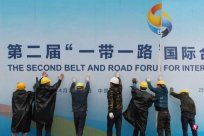
Global multinational companies have advocated the "China Plus One" strategy more than 10 years ago to reduce dependence on China. Do not put all eggs in a basket.However, China's past production costs are relatively low, and with the advantages of huge and complete industrial chain and abundant labor resources, China's "world factory" status is difficult to shake.
However, in recent years, the Sino -US trade war and scientific and technological wars have intensified, China's crown disease prevention "zero zero" policy has brought tremendous pressure on global supply chain, and geopolitical risks have increased.Promote the intensity of "China plus one".
Now the international supply chain is shuffling.India, which has won the favor of many well -known enterprises, has become more and more obvious to become the selection of Chinese alternative choices.
In May this year, Apple supplier Foxconn invested 500 million US dollars (about S $ 670 million) in TELANGANA in southern India.Indian Information Technology Minister Chandraseca said at the time that companies such as Apple and Samsung intended to expand the production of electronic products in India, which was conducive to India's position as a global manufacturing center.
Apple CEO CEO Cook's early May of the fiscal quarter of the fiscal year in the fiscal year of Apple 2023 repeatedly mentioned that India is important to Apple.
Bloomberg reported that Cook and his deputy raised India 20 times at the call at the time, and pointed out that the Indian market was at a turning point, and many Indians were entering the middle class.Apple did not disclose revenue from the Indian market in the financial report, but according to previous reports, Apple's sales in India nearly $ 6 billion in India this year.
Japan Sony Group is also building India to the next growth point.At a briefing held in Tokyo in May this year, Sony's person in charge of India N.P. Xin went to the scene to introduce Sony's business development in India and refer to India as a "place of opportunities."
Japan Economic News said that Sony arranged N.P. Xin Yuandao to attend the explanation meeting, reflecting the group's high hopes for India.Yoshida Yoshida, chairman and CEO of Sony Group, put forward the goal of "direct contact with 1 billion people" at the briefing meeting, showing that having more than 1.4 billion people is a major factor in India to become China's rivals.
According to the United Nations estimation, the Indian population has exceeded 1.428 million at the end of April this year, which is slightly higher than China's 1.425 million, replacing China as the world's first population.
Mei Nong, a senior researcher at the East East South Asian Research Institute in Singapore, pointed out in the United Morning Post that the Chinese population is rapid and aging, and labor force has continued to decrease, leading to rising labor costs. India has a relatively young population and growing labor force.It is more advantageous than China.
Mei Nong said: "India and China have many common advantages, so they can replace China as a manufacturing base in some aspects. India has a large number of trained labor and wages are more competitive., It means that the domestic market in India is huge. "
India has the ambition to become the next world factory, so the government has adopted a variety of measures to attract foreign capital.This is one of the reasons why multinational companies implement the "China Plus One" strategy.
In 2021, the Indian government launched a financial reward plan of 73.5 billion rupees (about S $ 1.2 billion) to reward manufacturers to manufacture and export laptop computers, tablet computers, and personal computers such as India.In May this year, the official increased the total amount of the award plan to 170 billion rupees.
The chairman of the Indian Electronics Industry Association Sri Sanjie believes that this will help India become the IT product hardware manufacturing center and increase exports.The Minister of Electronics and Information Technology of India told the local media that India's electronics manufacturing industry has continued to grow at a compound annual growth rate (CAGR) in the past eight years; India is now the world's second largest mobile phone production country,This year's mobile phone export volume will exceed $ 11 billion, playing an important role in Indian electronic products exports.
At present, Indian mobile phone exports account for 46%of the total export of electronic products, of which Apple iPhone accounts for about half of the total mobile phone export.
Industry and experts point out that infrastructure is backward, bureaucracy, and protectionism with trade policies, etc., which has led India to still have only a small role in the global supply chain.However, India has been improving and caught up.
According to the World Bank data, India's manufacturing exports in 2021 are only one -tenth of China, but exceeding all emerging markets except Mexico and Vietnam.Electronic products are the most increased area.Since 2018, India's electronic product exports have doubled.
Swati Babe, an expert in cross -border trade financing business, told the Indian Economic Times that the Indian government vigorously promotes the development of infrastructure and logistics and helps India establish a flexible supply chain.
Taking the Indian government cost $ 900 million in the port of Karala State Construction Container ports as an example, Babel said: "This container port can help India push products faster to the market and improve the global market in the global market.Competitiveness. "
The port of the Karara container is expected to be completed in September this year. It is the first container transshipment port in India. Once it is put into operation, it will become the gateway to India to international transport.
Mei Nong also mentioned in the Morning Post that the lack of logistics infrastructure has made it difficult for India's domestic cross -state transportation products and services, which limits India's potential to attract foreign capital.However, benefiting from the geopolitical tension between China and the United States, India's future development is expected.
Mei Nong said: "India is unlikely to replace China as a global manufacturing center in a short period of time, but in the long run, everything is possible."
Southeast Asia Geographical location is superior to Ma Yintai's business opportunities greatly
"China Plus One" strategy advocates that multinational companies transfer some or most investment in China to other countries, especially neighboring Chinese countries.In addition to India, members of Asian, such as Vietnam, Indonesia, Thailand, Malaysia, etc., which are superior geographical location, are also the first choice for "Kaichi".
Southeast Asia is one of the fastest growing areas in the world. According to data from the Asian Development Bank, the economic growth rate of Southeast Asia in 2022 is 5.5%. This year, it is expected to achieve 4.7%growth.Increased by 2.9%.In other words, Asia's growth is faster than the global average.
ASEAN BRIEFING, a website that has long -term follow -up of Asia Safe Commercial, Trade, Supervision and Investment and other messages and data.The environment of the map.
According to statistics, the total population of 10 member states in Asia is about 662 million, and the GDP (GDP) is as high as US $ 3.2 trillion.By 2030, Southeast Asia is expected to become the largest single market in the world.
Asiabean countries have seen business opportunities from the transformation of multinational companies seeking diversified supply chain, and have introduced preferential measures and support policies to attract foreign capital, including tax cuts, increasing business convenience, increasing infrastructure investment, and in the special economic zone and free tradeThe district provides rewards and so on.
■ Vietnam: The biggest beneficiary of the "Kaichi" strategy
Vietnam has always been the biggest beneficiary of the "China Plus One" strategy, thanks to the low local labor and shippingStrategic location.In 2020 alone, Vietnam's manufacturing industry attracted 58%of the total direct investment in foreign countries, and the export volume also increased by 14.8%.The United States is the largest export place for Vietnamese products, followed by China, Japan and South Korea.
As early as 2012, South Korea's Samsung Group promoted the "Vietnam Second Factory" investment project, the biggest consideration is the cost.Xinhua News Agency reported that Samsung currently invested about $ 18 billion in Vietnam and has six factories, two of which focus on the production of smartphones and supplies to the North American and European markets.In 2021, Vietnam's Samsung mobile phone accounted for 60%of the company's total capacity.
In addition to the electronics industry, many shoe and clothing brands have also turned to the Southeast Asian market.Vietnam has gradually replaced China as the largest shoe production place for sports brands such as Adidas and Nike.In 2020, more than half of Nike's shoe products were produced in Vietnam, and Adidas had 40 %.
Vietnamese Prime Minister Fan Mingzheng announced in 2021 to announce the blueprint of the development of national transportation infrastructure development. It is announced that in the next 10 years, it is necessary to build an infrastructure such as highway, upgrading international airports and ports of 4,000 kilometers in the next 10 years.World factory.
Although the Sino -US trade war allows Vietnam to collect fisheries, it depends on the US market and has also caused Vietnam to be affected by the weakening of the European and American markets.According to the Vietnam Statistics Administration of Statistics, Vietnam's export volume in January this year was US $ 25.08 billion, a year -on -year decrease of 21.3%.The United States is the largest export market in Vietnam with an export value of $ 7.6 billion.
■ Thailand: Have the complete industrial chain
Thailand is the second largest economy in Asia, and it is also an important automobile manufacturing center in Southeast Asia.As early as 1980, a large number of foreign investment, especially Japanese companies to build factories in Thailand, so Thailand has established a complete industrial chain.Coupled with the advantages of huge domestic and foreign markets and broad radiation range, the ability of Thailand to assemble cars and production parts in Thailand is relatively high among members of the Asia fine security.
In addition to the automotive industry, the industrial chain of electronic products and textile manufacturing is also being transferred to Thailand.Japan Economic News quoted sources in April this year that Apple is negotiating with suppliers to produce laptop MacBook in Thailand and expand production outside China.In fact, Apple has produced a large number of Apple Watch in Thailand for more than a year.
In order to attract more foreign capital, the Thai government has improved the business environment and simplified the process of applying for a factories.The latest data from the Thai Investment Promotion Commission shows that in the first three months of this year, Thailand's foreign direct investment, large -scale electronic projects and other key industries have increased by 77%to $ 5.5 billion.
■ Indonesia: Rich and natural resources for population
Indonesia is one of the main Southeast Asian countries that undertake international enterprise industrial transfer, which is due to its huge population, rich natural resources, and continuous improvement of investment environment.
At the time of 2020 global crown diseases and the intensification of the Sino -US trade war, the Indonesian government established a special working group to attract foreign investment from China to Indonesia.Shortly after the establishment of a special work group, Indonesian President Zoko announced that at least 17 multinational companies were interested in transferring to Indonesia. The total investment in these companies in China was $ 37 billion.
The data released by the National Bureau of Statistics of Indonesia in February this year shows that the GDP of Indonesia in 2022 increased by 5.31%year -on -year, the highest growth rate since 2013;The level increased by 44.2%year -on -year.
Indonesia is also the largest economy in Asia and the largest population in the region, with a population of 276 million.Indonesia's population structure is relatively young, and nearly half is under 30, which means that it has the advantage of young labor.
The United Nations Commission of Population and Development estimates that Indonesia's labor population is expected to increase from 140.2 million in 2021 to 146.9 million at the end of 2026.The sustainable growth of the labor age and the improvement of education have benefited Indonesia benefited from the demographic dividend in the short period of time.
Rich resources also make Indonesia profit in the complex international situation.After the Russian and Ukraine War, the global commodity prices rose. Indonesia, as the main supplier of power coal, palm oil, nickel and steel, in 2022, the export of commodities of Grand Congress set a record of $ 292 billion.
Nickel was mainly used in the production of stainless steel and other products, but with the development of new energy vehicles, as an important raw material for manufacturing electric vehicles, nickel is becoming more and more important.Indonesia has the world's largest nickel ore reserves and output, and is an important area for foreign investment.
■ Malaysia: Strong economic growth
Frederic Neumann, chief Asian economist and co -executive of Asia, said at a media report conference that Malaysia was listed as one of the strong economic growth of Southeast Asia, and it was also a global supply of global supply.One of the main beneficiaries of the chain group.
The first quarter of Malaysia GDP increased by 5.6%year -on -year, exceeding market expectations.During the same period, Malaysia received a foreign direct investment of RM37.5 billion (about S $ 11 billion), mainly investing in manufacturing.
In order to improve its competitiveness, Malaysia's self -positioning is the main logistics center of the region.The executive director (service and development) of the Malaysian Investment and Development Bureau pointed out that the logistics industry is essential for boosting trade, business efficiency and stimulating economic growth.
Infrastructure improvement, increased freight volume, and structural growth of e -commerce have made the Malaysian logistics industry a significant development.The Malaysian government has formulated a number of plans, including the launch of the "National Transport Policy from 2019 to 2030" to improve logistics and cooperate with e -commerce development, promote the upgrading and expansion of ports, etc., and improve productivity and competitiveness.
The Malaysian government also supports the development of the industry by issuing an international comprehensive logistics service (IILS) status (IILS).IILS status refers to companies that can provide comprehensive and seamless logistics services in regions or globally in the form of a single entity.Malaysia has not imposed any equity restrictions. So far, 259 companies have obtained IILS, of which 223 are local logistics companies in Malaysia, and the remaining 36 are foreign companies.




